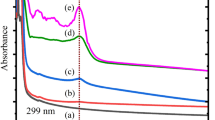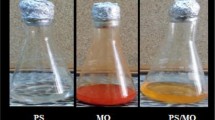Abstract
Polystyrene polymer (PS)/Al2O3 nanocomposite films were synthesized from PS:Al2O3 (1–x):x mixtures (x = 3 wt%) via solution casting method. These nanocomposite films were exposed to 5 MeV proton beam of different fluences. The proton beam induced changes in optical and luminescence properties of PS and PS:Al2O3 films have been investigated using FTIR, UV-visible, Photoluminescence and thermoluminescence studies. FTIR studies concede reduction in the peak intensity due to doping of Al2O3 and proton irradiation. The UV-visible spectra show shifting of absorption edge with increasing fluence. This can be attributed to creation of conjugated system of bonds. The band gap of PS and 3 wt% Al2O3 doped PS is observed to be 4.38 eV and 4.34 eV, respectively, whereas the band gaps of proton irradiated 3 wt% Al2O3 doped PS films are found to be 4.28 eV and 4.23 eV at the fluences of 1 × 1012 ions/cm2 and 1 × 1013 ions/cm2, respectively. The photoluminescence emission spectra show three peaks, wavelength at 411 nm, 435 nm and 462 nm corresponding to the PS in violet-blue region when excited with near UV wavelength of 380 nm. The intensity of emission peaks was found to increase with increasing fluence. The thermoluminescence curves of PS/Al2O3 were analysed using glow curve deconvolution method (GCD). The increase in TL peak intensity of the glow curve was observed as fluence increase.






Similar content being viewed by others

References
Jeeju PP, Jayalekshmi S, Chandrasekharan K, Sudheesh P (2012) Size dependent nonlinear optical properties of spin coated zinc oxide-polystyrene nanocomposite films. Opt Commun 285:5433–5439. https://doi.org/10.1016/j.tsf.2012.12.043
Elashmawi IS, Hakeem NA, Marei LK, Hanna FF (2010) Structure and performance of ZnO/PVC nanocomposites. Phys B Condens Matter 405:4163–4169. https://doi.org/10.1016/j.physb.2010.07.006
Fernandes DM, Hechenleitner AA, Lima SM, Andrade LH, Caires AR, Gómez Pineda EA (2011) Preparation, characterization, and photoluminescence study of PVA/ZnO nanocomposite films. Mater Chem Phys 128:371–376. https://doi.org/10.1016/j.matchemphys.2011.03.002
Tripathi SK, Kaur R, Jyoti (2015) Investigation of non-linear optical properties of CdS/PS polymer nanocomposite synthesized by chemical route. Opt Commun 352:55–62. https://doi.org/10.1016/j.optcom.2015.04.042
Maji P, Choudhary RB, Majhi M (2016) Structural, optical and dielectric properties of ZrO2 reinforced polymeric nanocomposite films of polymethylmethacrylate (PMMA). Optik 127:4848–4853. https://doi.org/10.1016/j.ijleo.2016.02.025
Karlsson M, Palsgard E, Wilshaw PR, Silvio LD (2003) Initial in vitro interaction of osteoblasts with nano-porous alumina. Biomaterials 24:3039–3046. https://doi.org/10.1016/S0142-9612(03)00146-7
Zhang Z, Lei H (2008) Preparation of a -alumina / polymethacrylic acid composite abrasive and its CMP performance on glass substrate. Microelectron Eng 85:714–720. https://doi.org/10.1016/j.mee.2008.01.001
Bhavsar S, Patel GB, Singh NL (2018) Effect of γ-irradiation on optical properties of Eu2O3-doped polystyrene polymer films. Luminescence 33:1243–1248. https://doi.org/10.1002/bio.3541
Bhavsar S, Patel GB, Singh NL (2018) Investigation of optical properties of aluminium oxide doped polystyrene polymer nanocomposite films. Phys B Condens Matter 533:12–16. https://doi.org/10.1016/j.physb.2017.12.055
Baba EM, Cansoy CE, Zayim EO (2016) Investigation of wettability and optical properties of superhydrophobic polystyrene-SiO2 composite surfaces. Prog Org Coat 99:378–385. https://doi.org/10.1016/j.porgcoat.2016.06.016
Patel GB, Singh NL, Singh F (2017) Modification of chitosan-based biodegradable polymer by irradiation with MeV ions for electrolyte applications. Mater Sci Eng B 225:150–159. https://doi.org/10.1016/j.mseb.2017.08.023
Tauc J, Grigorovici R, Vancu A (1966) Optical properties and electronic structure of amorphous germanium. Phys Status Solidi 15:627–637
Chahal RP, Mahendia S, Tomar AK, Kumar S (2012) C-irradiated PVA/Ag nanocomposite films: materials for optical application. J Alloys Compd 538:212–219. https://doi.org/10.1016/j.optmat.2015.12.049
Bharti ML, Singh F, Ramola RC, Joshi V (2017) Photoluminescence and reflectivity studies of high energy light ions irradiated polymethyl methacrylate films. Opt Mater 73:550–554. https://doi.org/10.1016/j.optmat.2017.09.018
Sharma S, Vyas R, Shrivastava S, Vijay YK (2011) Effect of swift heavy ion irradiation on photoluminescence properties of ZnO/PMMA nanocomposite film. Phys B Condens Matter 406:3230–3233. https://doi.org/10.1016/j.physb.2011.05.030
Kim E, Kyhm J, Kim JH, Lee GY, Ko DH, Han IK, Ko H (2013) White light emission from polystyrene under pulsed ultra violet laser irradiation. Sci Rep 3:1–4. https://doi.org/10.1038/srep03253
Kitis G, Gomez-Ros JM, Tuyn JWN (1998) Thermoluminescence glow-curve deconvolution functions for first, second and general orders of kinetics. J Phys D Appl Phys 31:2636–2641. https://doi.org/10.1088/0022-3727/31/19/037
Dobruchowska E, Okrasa L, Glowacki I, Ulanski J, Boiteux G (2004) The “ wet dog ” effect in polymers as seen by thermoluminescence. Polym. 45:6027–6035. https://doi.org/10.1016/j.polymer.2004.06.019
Pender LF, Fleming RJ (1977) Thermoluminescence in polystyrene. J Phys C Solid State Phys 10:1571–1586. https://doi.org/10.1088/0022-3719/10/9/027
Acknowledgements
The financial support provided by IUAC, New Delhi is also gratefully acknowledged. Authors are thankful to Dr. Balak Das, Dept. of Physics, University of Lucknow for providing XRD measurement.
Author information
Authors and Affiliations
Corresponding author
Additional information
Publisher’s Note
Springer Nature remains neutral with regard to jurisdictional claims in published maps and institutional affiliations.
Rights and permissions
About this article
Cite this article
Bhavsar, S., Singh, N.L., Suryanarayana, S.V. et al. Proton Beam Induced Modification of Luminescence Properties of Polystyrene/Al2O3 Polymer Nanocomposites. J Fluoresc 29, 1007–1012 (2019). https://doi.org/10.1007/s10895-019-02414-z
Received:
Accepted:
Published:
Issue Date:
DOI: https://doi.org/10.1007/s10895-019-02414-z



